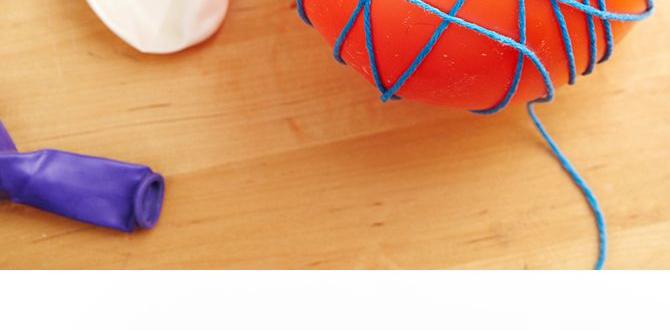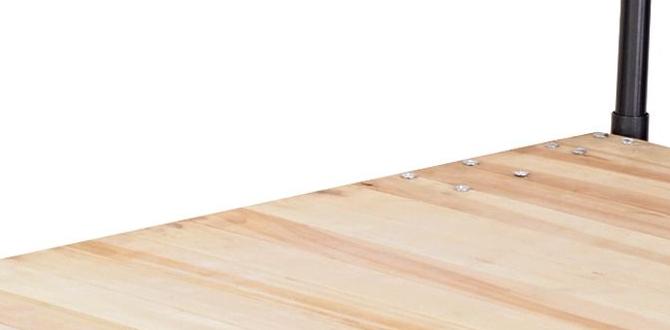Have you ever looked at your basement and thought it could be more? Many people see a dark, unused space. But what if it could be a cozy playroom, a home theater, or even an extra bedroom? DIY basement finishing can transform that idea into reality.
Imagine setting up your own game room where friends can gather. Picture a bright area filled with light and laughter. DIY finishing takes planning, creativity, and some hard work, but the results are worth it. Did you know many basements are left empty, simply waiting for someone to unlock their potential?
In this article, we will guide you from planning to perfection. You’ll learn easy steps to make your dream basement a reality. Let’s dive into the exciting journey of DIY basement finishing and see how you can turn that space into something special.
Table of Contents
Diy Basement Finishing: From Planning To Perfection Guide

DIY Basement Finishing: From Planning to Perfection
DIY basement finishing is a fun project that can transform your space. You can enhance your home and add value. Start with a solid plan. Measure your area and brainstorm ideas. What do you want the basement to be—a cozy den or a vibrant playroom? Use budget-friendly materials for a stylish look. A fun fact: finished basements can increase your home’s value by up to 10%! With thoughtful planning, you can achieve perfection in your DIY project.Understanding the Benefits of Finishing Your Basement
Increase usable living space. Enhance property value and appeal.Transforming your basement can change your home’s feel. It creates extra living space for family fun or hobbies. More space means more room for activities without crowding your main areas. Finishing your basement also boosts your property value. Many buyers see a finished basement as a plus. It makes your home more attractive and can even help you sell faster.
What are the benefits of finishing your basement?
Finishing your basement increases usable living area and adds value to your property.Key Benefits:
- Increases usable living space.
- Enhances property value.
- Makes home more appealing to buyers.
Planning Your Basement Finishing Project
Assessing the space and determining needs. Setting a realistic budget and timeline.Before diving into your basement finishing adventure, take a good look around. Assessing the space is key. Think about what you need. Do you want a cozy movie room or a fun play area? Whatever your dream is, note it down!
Next up, let’s talk money. Setting a realistic budget is super important. You don’t want to end up in a hole deeper than your basement! Plan for some extra cash, just in case. It’s like finding money in your couch cushions—always a nice surprise!
| Planning Steps | Details |
|---|---|
| Assess the Space | Identify needs and desires. |
| Set a Budget | Include extra funds for surprises. |
| Create a Timeline | Allow time for each step. |
Get your measuring tape and calculator ready. A little planning helps turn dreams into reality. And remember, a well-planned basement makes for a much happier DIY journey!
Essential Tools and Materials for DIY Finishing
List of tools required for the project. Recommended materials for insulation, framing, and drywall.Before starting your DIY basement project, gather these important tools and materials. You’ll need some basic tools for the job:
- Measuring tape
- Level
- Hammer
- Saw
- Drill
Recommended materials for insulation include:
- Foam board
- Fiberglass batts
For framing and drywall, consider:
- Wood studs
- Drywall sheets
- Joint compound
Having the right tools and materials is key to a successful DIY basement finish. Ready to get started?
What tools do I need to finish my basement?
You need some essential tools to finish your basement. Measuring tape, a hammer, a level, and a drill are great to have. These will help you get the job done right!
Steps for Preparing Your Basement
Cleaning and waterproofing the area. Addressing potential moisture and heating issues.Start by giving your basement a good scrub. Remove clutter and dust bunnies. A clean space helps everything else feel fresh. Next, check for leaks. Nobody wants a swimming pool in their basement! Apply waterproofing sealant to walls and floors. This helps keep water out and your plans dry.
| Task | Description |
|---|---|
| Clean | Remove all items and dust. |
| Waterproof | Seal walls and floors. |
Now, look for moisture issues. Check for mold or damp spots; that’s a clear sign to act fast. Install a dehumidifier if needed to keep the space dry. Finally, ensure proper heating. A chilly basement is not cozy. You want it to feel like a warm hug, not an icy cave!
Framing Your Basement Walls
Best practices for wall framing. Tips for electrical and plumbing considerations.Framing basement walls is like building a blanket fort, but way more serious! Start with 2×4 lumber for sturdy support. Ensure everything is straight and level; a crooked wall won’t win any awards! Remember to consider plumbing and electrical lines. Before enclosing the walls, plan where your outlets will go. It’s better to drill holes now than later when you’d rather be binge-watching your favorite show. For quick reference, check this table:
| Best Practices | Tips for Plumbing & Electrical |
|---|---|
| Use treated lumber for moisture. | Locate pipes before framing. |
| Space studs 16 inches apart. | Install junction boxes in accessible spots. |
| Nail every joint securely. | Plan for future needs! |
With these tips, your basement walls will be framed like a pro. And when your friends ask who did this nifty work? You can proudly say, “Me, the DIY champion!”
Insulation and Soundproofing Techniques
Types of insulation suitable for basements. Methods for soundproofing between rooms.Keeping a basement cozy and quiet is vital. For insulation, fiberglass batts and foam boards are great choices. They trap heat and keep cold away, making your space comfy. For soundproofing, adding mass-loaded vinyl or acoustic panels works wonders.
- Fiberglass batts: Easy to install and cost-effective.
- Foam boards: Excellent for cold resistance and moisture control.
- Mass-loaded vinyl: Great for blocking noise between rooms.
- Acoustic panels: Help absorb sound, making spaces quieter.
What insulation is best for basements?
For basements, fiberglass batts and foam boards are ideal. They provide warmth and block moisture.
How do you soundproof a basement?
To soundproof a basement, use mass-loaded vinyl and acoustic panels. These materials help keep noise from traveling.
Installing Drywall and Finishing Touches
Stepbystep guide to drywall installation. Techniques for taping, mudding, and painting.Wondering how to hang drywall like a pro? First, measure your walls and cut the drywall sheets. Grab a buddy; it’s way easier with help! Next, attach the sheets to the wall studs with screws. For the finishing touches, use tape along the seams. Start mudding by spreading joint compound over the tape. Don’t worry if it gets messy; that’s half the fun! Finally, sand it smooth and paint for a sleek look. Your basement will shine brighter than a disco ball!
| Step | Description |
|---|---|
| 1 | Measure and cut drywall sheets. |
| 2 | Attach sheets to walls with screws. |
| 3 | Tape seams securely. |
| 4 | Mud the taped seams with compound. |
| 5 | Sand it smooth and paint it. |
Design Ideas and Practical Layouts
Popular basement design concepts. Maximizing space with functional layouts.When thinking of basement designs, creativity and space matter! Popular ideas include cozy family rooms, fun play areas for kids, and even home theaters for movie nights. To make the most of your basement, think about functional layouts. This means arranging furniture to fit and flow well. You can create separate areas like a mini gym or a stylish workspace. The key is to use colorful decorations and clever storage so your basement isn’t just extra space, but the coolest spot in your house!
| Design Idea | Description |
|---|---|
| Family Room | A cozy area for family fun! |
| Play Area | Safe space for kids to explore. |
| Home Theater | A mini cinema experience. |
| Gym | Your personal workout zone. |
| Office Space | Focus zone for work or study. |
Meeting Local Building Codes and Regulations
Importance of permits and inspections. Common local regulations to consider.Before diving into your basement project, it’s vital to check local rules. Think of permits and inspections as your project’s best friends! They keep you safe and make sure everything is up to code. Ignoring them is like trying to bake a cake without measuring flour—yikes!
| Common Local Regulations | Why They Matter |
|---|---|
| Ceiling Height | It ensures there’s enough room for activities! |
| Electrical Systems | Safety first! No one wants to become a human lightbulb. |
| Emergency Exits | Because you need a way out in case of monster encounters! |
Following these regulations could avoid future headaches. Remember, it’s all about creating a comfy, safe, and fun space where you can unleash your creativity!
Common Challenges and Solutions in DIY Finishing
Identifying frequent issues faced during the process. Practical solutions and troubleshooting tips.Many people face challenges with DIY basement finishing. Common issues include moisture, poor lighting, and uneven floors. Each problem has practical solutions. Here are some tips to help you troubleshoot:
- For moisture, use a dehumidifier and seal cracks.
- Improve lighting by adding brighter fixtures or using mirrors.
- Level uneven floors with floor leveling compound.
These steps can make your basement project easier and more enjoyable.
What common mistakes should I avoid?
Some common mistakes include rushing the planning stage, neglecting ventilation, and ignoring building codes. Take your time and think carefully while planning. Make sure the space is safe and comfortable to use.
Maintaining Your Finished Basement
Routine upkeep and improvement suggestions. Preventative measures for moisture and damage.Keeping your finished basement in shape is key to enjoying your space. Regular cleaning will help make it cozy. Dust bunnies love corners, so check those often! For moisture, use a dehumidifier. Too much water can cause trouble and turn your basement into a swimming pool—yikes! Here’s a quick table with tips:
| Maintaining Your Basement | Tips |
|---|---|
| Routine Cleaning | Dust regularly and clear clutter. |
| Moisture Control | Use dehumidifiers and check for leaks. |
| Damage Prevention | Inspect walls and floors for cracks. |
Keep an eye on these things, and your basement will stay perfect. Remember, prevention is better than a soggy carpet!
Conclusion
In conclusion, DIY basement finishing can turn a dark space into a cozy room. Start with careful planning and gather your materials. Follow the steps for framing, insulation, and drywall. Don’t rush—take your time for the best results. You can do this! For more tips and ideas, check out additional guides or videos. Let’s make your basement perfect together!FAQs
What Are The Essential Steps To Take When Planning A Diy Basement Finishing Project?To plan your DIY basement finishing project, start by deciding how you want to use the space. We should check the basement for leaks or problems to fix. Next, we’ll make a list of materials we need, like walls, flooring, and lights. Then, we can draw a simple layout to see where everything will go. Finally, choose a time to start working and gather helpers if you need them!
How Can I Determine The Right Materials And Insulation Methods For My Basement Finishing?To choose the best materials and insulation for your basement, start by looking at your climate. If it’s cold, you’ll need thick insulation to keep it warm. Check for any damp spots first and fix them. Use materials that resist mold, like special boards. Ask a friend or a contractor for help if you’re unsure.
What Plumbing And Electrical Considerations Should I Keep In Mind During The Finishing Process?During the finishing process, you should check your plumbing and electrical systems. Make sure pipes are placed well so they don’t get in the way. We also need to ensure electrical wires are safe and not too close to water. Keep all connections tight and use good materials. Finally, always follow safety rules and ask for help if needed.
How Do I Create A Functional Layout That Maximizes Space And Meets My Needs In A Finished Basement?To create a good layout in your finished basement, start by thinking about what you want to do there. Make a list of your needs, like a play area, a cozy couch, or a desk for homework. Use soft furniture that fits well and leaves space to walk around. You can also divide the space using rugs or furniture to make different areas. Lastly, keep it bright with lights to make it inviting and fun!
What Are Some Common Mistakes To Avoid When Finishing A Basement On My Own?When finishing a basement, be sure to plan first. Don’t skip measuring the space. You want to make sure everything fits. Always check for water leaks before you start. It’s also important to get the right permits so you’re following the rules. Lastly, remember to ask for help if you need it!


